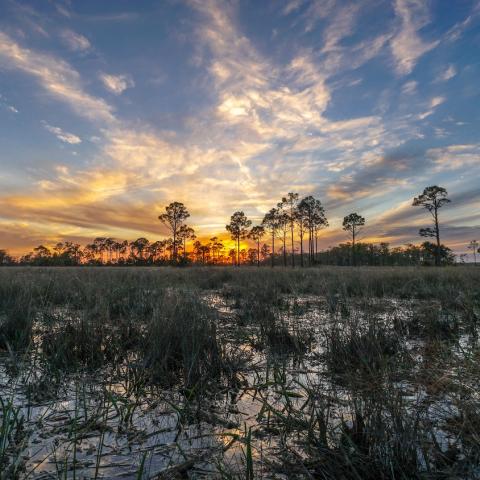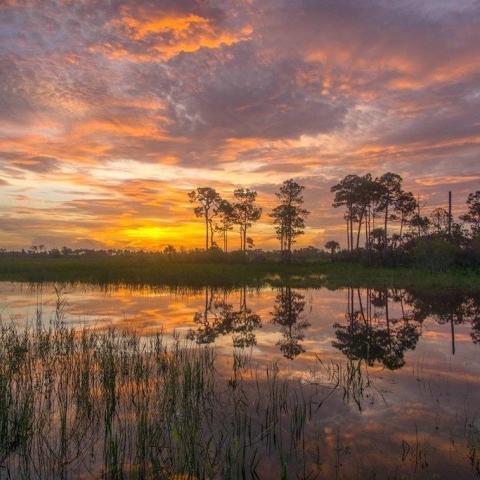
Rob Wallace, assistant secretary for Fish and Wildlife and Parks, went on a python capture mission in the Everglades in October/DOI
Rob Wallace's two gloved hands were tightly clenched around the snake's neck. It wasn't a monster Burmese python, but it was big enough to justify Wallace's complete attention and tight grip.
Wallace, the assistant secretary for Fish and Wildlife and Parks in the Interior Department, had traveled to the Everglades in October to get a first-hand look at the problems created by the pythons, and to go out on a night hunt with Everglades National Park Superintendent Pedro Ramos and Tom Rahill of Swamp Apes, a group that works with military veterans in wilderness settings.
Since 2018, when the National Park Service began working with several state of Florida python removal programs, more than 8,000 of the big snakes have been captured.
Burmese pythons are just one invader of park lands, however. Lionfish swim in marine waters touching Everglades, Big Cypress, Biscayne, Dry Tortugas, and Virgin Islands national park, other reptilian invasive species have been seen in the parks located in South Florida, and shellfish from the other side of the world are taking over places such as Lake Powell at Glen Canyon National Recreation Area, Lake Mead at its namesake NRA, and other lakes.
Interior staff note that the "nation has invested billions of dollars on ecosystem restoration in the Everglades and other areas of South Florida, but invasive Burmese pythons numbering in the tens of thousands are driving almost all native mammals to the brink of extinction in the Everglades, and and now impacting bird populations. They even are killing American alligators. The pythons and other invasives in South Florida have transformed the ecosystem to the point where it barely resembles a North American fauna. Interior scientists and managers are doing innovative and pioneering research to limit the python population by manipulating their biology and reproductive patterns, to try to protect the ecosystems and salvage the huge public investment in ecosystem restoration."
On August 7, 2019, Florida Governor Ron DeSantis announced an effort to increase python removal in the Everglades. The Park Service has joined with Florida Fish and Wildlife Conservation Commission and South Florida Water Management District to develop a unified python removal program in South Florida.
To keep attention focused on python removal, Park Service staff meet weekly with Florida partners to align the different python removal programs into one unified program, implement the expansion envisioned by Governor Ron DeSantis, and further increase python removals. This year the Park Service also expanded access to lands for python removal, allowing access to some wilderness roads, airboat access in upper Shark Slough within Everglades National Park, and facilitating off-road vehicle access on primary trails on Big Cypress National Preserve.
In an effort to battle these species that threaten to upend some ecosystems, the Park Service also has signed memoranda of understanding with the North American Invasive Species Management Association, the U.S. Fish and Wildlife Service, and Wildlife Forever to better coordinate invasive species prevention efforts. These agreements bring several important initiatives to address invasive animal species: “PlayCleanGo Stop Invasive Species InYour Tracks,” “Clean Drain Dry,” and “Stop Aquatic Hitchhikers.”
Another important MOU Interior staff pointed to is focused on conservation of islands, atolls, and reefs under U.S. jurisdiction, mainly through the control of invasive species. The MOU includes the National Park Service, U.S. Fish and Wildlife Service, Island Conservation, and other federal agencies and not-for-profit agencies.
"The National Park Service this year established an Invasive Animal Program to improve how we deal with these complex, far-reaching issues," Wallace told the Traveler in an email exchange. "Our top priorities are to let people know the extent of the damage invasive animals species inflict on parks and to expand formal and informal partnerships with local, state, federal and tribal entities and local communities near parks.
"We also collaborate with other agencies and universities to find existing and encourage new and emerging technologies that can be used to control invasive animal species," he added. "A recent scientific study indicates that some parks have strategies to manage invasive animals and that those strategies could be useful in the development of a larger program. Partnerships with state and local agencies and adjacent private landowners are critical - it's important to work across boundaries. It's also vital that we engage the public and enlist their support as part of invasive prevention and control programs."
For some parks, the problem has gone beyond being an isolated problem and turned into a malevolent force that is literally impairing the very nature of the parks and some of the reasons they were set aside in the first place. More than 300 invasive animal species today present an ecosystem-upsetting menagerie in the National Park System.
Wallace pointed out that the Park Service this year created an Invasive Animal Program "to improve how we deal with these complex, far-reaching issues. Our top priorities are to let people know the extent of the damage invasive animals species inflict on parks and to expand formal and informal partnerships with local, state, federal and tribal entities and local communities near parks."
But invasive species is just one greatly challenging issue that is confronting the National Park Service, Wallace acknowledged in the email conversation.
Traveler: Climate change is wreaking havoc with national park units in Alaska, as permafrost thaws, leading to road slippage, erosion of archaeological artifacts, and impacts cultural areas. What can Interior/NPS do to protect these areas?
Wallace: Climate change is real. Impacts of a changing climate need to be understood and addressed. The Department of the Interior's role is to follow the laws in carrying out our responsibilities using the best science. We are using the best available science to best understand the impacts and appropriately manage public lands.
As stewards of America’s iconic natural, cultural and historic resources, the National Park Service (NPS) is responsible for their care while we support and encourage their public use – today and for generations to come. Our work to understand how our changing climate affects park resources and infrastructure is part of our core responsibility to protect parks.
The NPS uses science and research to understand:
• How park ecosystems function and what affects them;
• Risks to park resources from environmental hazards; and
• Factors that affect historic and cultural resources.
Climate change is one factor that affects park ecosystems, resources, and infrastructure. It is our job to understand and know how to manage effects from a changing climate so that we may protect park resources just as we manage the impacts of invasive species or erosion or wildfire.
Traveler: Sea level rise, stronger hurricanes, and storm surges are having great impacts on coastal parks, particularly those along the East Coast. Hurricane Dorian, for example, cut 54 breaches into Cape Lookout National Seashore, and tore up a section of Highway 12 that runs down Cape Hatteras. Should Interior/NPS work to bolster/buildup these parks to try to protect them from similar storms going forward, or should some parks be allowed to exist at the whim of nature, as you will, since the Park Service’s mandate is to allow natural processes to proceed largely uninterrupted? Plus, as Cape Hatteras has long demonstrated, artificial hardening of barrier islands doesn’t work.
Wallace: While National Park Service policy favors natural processes, there are four circumstances where park managers have the flexibility to take various management actions including restoration, mitigation, and other intervention. The four circumstances are:
• When directed by Congress;
• In emergencies in which human life and property are at stake;
• To restore natural ecosystem functioning that has been disrupted by past or ongoing human activities; or
• When a park plan has identified the intervention as necessary to protect other park resources, human health and safety, or facilities.
Interior staff also pointed out a few success cases achieved in the battle against invasive species:
• Since their discovery in the Great Lakes in the 1980s, Interior and its partners have worked to prevent, contain and control invasive zebra and quagga mussels. The mussels clog municipal and industrial water supply pipes, foul recreational facilities and beaches, clog hydroelectric and irrigation infrastructure, and transform aquatic ecosystems pushing native species onto the endangered species list. They cause $500 million in damage annually in the Great Lakes region and could cause similar problems in the Pacific Northwest. Through collaboration with the Western Governors’ Association and federal, state and tribal agencies, Interior has led numerous activities to protect Western water supplies, water-based recreation and aquatic ecosystems from the spread of invasive mussels.
• Interior experts provide key leadership, research and tactical assistance across the Great Lakes, Upper Mississippi River, and Ohio River basins to address the spread of Asian carp. The carp threaten a $7 billion annual commercial and recreational fishery in the Great Lakes, and would also destroy duck habitat that would harm hunting and birdwatching across the Great Lakes. They have already radically transformed the ecology of rivers “downstream” of the Great Lakes.
• Brown tree snakes have virtually exterminated all birds and other reptiles on the island of Guam, and regularly cause blackouts at US military installations there by crawling into electric transformers and short-circuiting them. Should they spread beyond Guam, they would pose a constant and severe ecological threat to the Hawaiian Islands, and its tourist economy. Early detection of brown tree snakes that might arrive in Hawaii or other snake-free islands from Guam is key in order to prevent new populations from establishing. In addition to helping DOD combat the snakes in Guam through innovate research, Interior researchers recently demonstrated that brown tree snake DNA remains detectable for up to 21 days after exposure to a snake. This may prove a valuable early-detection tool to allow rapid response to occur early in the invasion process and thus have higher odds of preventing establishment.
Meanwhile, Interior scientists are working to refine techniques to quickly detect the presence and spread of Rapid ŌhiʻaDeath (ROD), a disease spread by two invasive fungal pathogens that attack Ōhiʻa trees, the most abundant native tree in Hawai’i. In spring 2019, Interior through its Office of Native Hawaiian Relations, sponsored the “‘ŌhiʻaChallenge,” a competition to help identify advanced technological solutions to combat ROD.
As part of the Trump administration’s regulatory reform initiative, Interior also is exploring opportunities to develop National Environmental Policy Act categorical exclusions for certain invasive species management activities so economic and ecological damage from invasive species can be controlled earlier and more effectively.




 Support Essential Coverage of Essential Places
Support Essential Coverage of Essential Places






